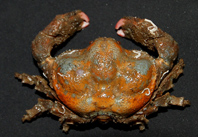Abstract
The mature larva and pupa of Neomida haemorrhoidalis are described and illustrated for the first time. The mature larva of Bolitophagus reticulatus is completely redescribed and illustrated, and its pupa is described for the first time. The differential diagnosis of the two species is presented. Information about their biology and life history is also given.
References
Ahrens, D. (2006) The phylogeny of Sericini and their position within the Scarabaeidae based on morphological characters (Coleoptera: Scarabaeidae). Systematic Entomology, 31, 113–144.
http://dx.doi.org/10.1111/j.1365-3113.2005.00307.xAndersson, J., Hjältén, J. & Dynesius, M. (2015) Wood-Inhabiting Beetles in Low Stumps, High Stumps and Logs on Boreal Clear-Cuts:Implications for Dead Wood Management. PLoS ONE 10 (3): e0118896.
http://dx.doi.org/10.1371/journal.pone.0118896Audisio, P. (2013) Fauna Europaea, version 2.6.2, updated 29 August 2013. Available from: http://www.faunaeur.org
Bouchard, P. & Steiner, W.E.Jr. (2004) First descriptions of Coelometopini pupae (Coleoptera: Tenebrionidae) from Australia, Southeast Asia and the Pacific region, with comments on phylogenetic relationships and antipredator adaptations. Systematic Entomology, 29, 101–114.
http://dx.doi.org/10.1111/j.1365-3113.2004.00230.xBurakowski, B., Mroczkowski, M. & Stefańska, J. (1987) Chrząszcze, Cucujoidea. Część XXIII, tom 14. Katalog fauny Polski. PWN, Warszawa, pp. 1–309.
Daggy, T. (1946) Notes on the ecology and taxonomy of certain pupae of the family Tenebrionidae (Coleoptera). Proceedings of the Indiana Academy of Sciences, 56, 253–260.
Emden, Van F.I. (1947) Larvae of British Beetles. VI. Tenebrionidae. Entomologist`s Monthly Magazine, 83, 154–171.
Franc, V. (2008) Darkling beetles (Coleoptera, Tenebrionidae) of Slovakian fauna and their ecosozological value. Matthias Belivs University (UMB Banská Bystrica) 4, 61–67.
Ghilarov, M.S. (1964) Family Tenebrionidae—Darkling Beetles. In: Ghilarov, M.S. (Ed.), Determination Key to Soil-dwelling Insect Larvae. Moscow, pp. 463–496, tab. 324–352. [in Russian]
Jonsell, M. & Hansson, J. (2011) Logs and stumps in clearcuts support similar saproxylic beetle diversity: implications for bioenergy harvest. Silva Fennica, 45 (5), 1053–1064.
http://dx.doi.org/10.14214/sf.86Knutsen, H., Rukke, B.A., Jorde, P.E. & Ims, R.A. (2000) Genetic differentiation among populations of the beetle Bolitophagus reticulatus (Coleoptera: Tenebrionidae) in a fragmented and a continuous landscape. Heredity, 84, 667–676.
http://dx.doi.org/10.1046/j.1365-2540.2000.00691.xKondracki, J. (2000) Geografia regionalna Polski. PWN, Warszawa, pp. 279–293.
Lawrence, J.F. (1982) Coleoptera, In: Parker S.P. (Ed.), Synopsis and Classification of Living Organisms. McGraw-Hill, New York, pp. 482–553.
Lawrence, J.F. (1989) Mycetophagy in Coleoptera: feeding strategies and morphological adaptations, In: Wilding, N., Collins, N.M., Hammond, P.M. & Webber, J.F. (Eds.), Insect-Fungus Interactions. Academic Press, London, pp. 1–24.
Lik, M. (2005) Population dynamics of the black tinder fungus beetle Bolitophagus reticulatus. Folia biologica (Kraków), 53, 171–177.
http://dx.doi.org/10.3409/173491605775789452Löbl, I. & Smetana, A. (2008) Tenebrionoidea. Vol. 5, Catalugue of Palaearctic Coleoptera. Apollo Books, Denmark, pp. 1–670 .
Marczak, D., Lasecki, R. & Mroczyński, R. (2010) Materiały do poznania rozmieszczenia chrząszczy z rodziny czarnuchowatych (Coleoptera: Tenebrionidae) w Polsce. Wiadomości Entomologiczne, 29 (4), 273–281.
Matthews, E.G., Lawrence, J.F., Bouchard, P., Steiner, W. & Ślipiński, A. (2010) Tenebrionidae, 574–659. In: Leschen, R.A.B., Beutel, R.G., Lawrence, J.F. & Ślipiński, A. (2010) Handbook of Zoology. Arthropoda: Insecta. Coleoptera, Beetles. Volume 2: Morphology and Systematics (Elateroidea, Bostrichiformia, Cucujiformia partim) DeGruyter, Berlin, pp. 1–786.
May, B. (1994) An introduction to the immature stages of Australian Curculionoidea, family Curculionidae: Entiminae. In: Zimmerman, E.C. (Ed.), Australian Weevils (Coleoptera, Curculionidae). Vol, 2. CSIRO, Melbourne, pp. 475–481.
Midtgaard, F., Rukke, B.A. & Sverdrup-Thygeson, A. (1998) Habitat use of the fungivorous beetle Bolitophagus reticulatus (Coleoptera: Tenebrionidae): Effects of basidiocarp size, humidity and competitors. European Journal of Entomology, 95, 559–570.
Nadvornaya, L.S. & Nadvorny, V.G. (1991) Biology of the tenebrionids Bolitophagus reticulatus L. and Uloma culinaris L. (Coleoptera: Tenebrionidae) in the forest steppe zone of the Ukraine. Entomologicheskoe Obozrenie, 70, 349–354.
Nikitsky, N.B. & Schigel, D.S. (2004) Beetles in polypores of the Moscow region, Russia: checklist and ecological notes. Entomologica Fennica, 15, 6–22.
Nilson, T. (1997) Survival and habitat preferences of adult Bolitophagus reticulatus. Ecological Entomology, 22, 82–89.
http://dx.doi.org/10.1046/j.1365-2311.1997.00035.xPravdin, F.N. (1987) Ecology and morphology of insects inhabiting fungal substrates. Nauka, Moscow, pp. 45–56.
Purchart, L. & Nabozhenko, M.V. (2012) Description of larva and pupa of the genus Deretus (Coleoptera: Tenebrionidae) with key to the larvae of the tribe Helopini. Acta entomologica Musei Nationalis Praga, 52 (sup. 2), 295–302.
Radwan, S. (2002) Poleski Park Narodowy: monografia przyrodnicza. Wydawnictwo MORPOL, Lublin, pp. 1–272.
Reszel, R. & Grądziel, T. (2013) Roztoczański Park Narodowy: przyroda i człowiek. Wydawnictwo Lipiec, Zwierzyniec, 1–312.
Speight, M.C.D. (1989) Saproxylic invertebrates and their conservation. Council of Europe, Strasbourg, pp. 1–81.
Stebnicka, Z. (1991) Chrząszcze—Coleoptera. Zeszyt 91, Czarnuchowate—Tenebrionidae, Boridae, 1–96. Część XIX. Klucze do oznaczania owadów Polski.
Steiner, W.E.Jr. (2014) Larvae and pupae of two North American darkling beetles (Coleoptera, Tenebrionidae, Stenochiinae), Glyptotus cribratus Le Conte and Cibdelis blaschkei Mannerheim, with notes on ecological and behavioural similarities. In: Bouchard, P. & Smith, A.D. (Eds.), Proceedings of the Third International Tenebrionoidea Symposium, Arizona, USA, 2013. ZooKeys, 415, 311–327.
http://dx.doi.org/10.3897/zookeys.415.6891

